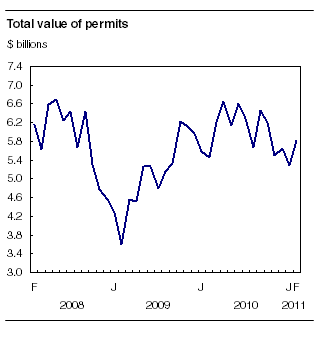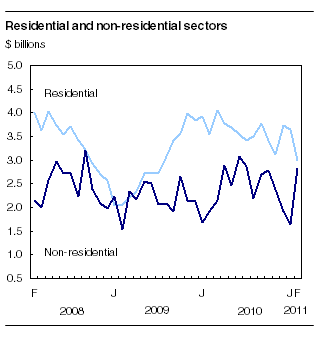Building permits
Archived Content
Information identified as archived is provided for reference, research or recordkeeping purposes. It is not subject to the Government of Canada Web Standards and has not been altered or updated since it was archived. Please "contact us" to request a format other than those available.
Related subjects
-
[an error occurred while processing this directive]
Municipalities issued building permits worth $5.8 billion in February, up 9.9% from January. The February advance was a result of gains in the non-residential sector in Alberta and Ontario, which more than offset the decline in the residential sector.

In the non-residential sector, the value of permits totalled $2.8 billion in February, up 72.9% compared with January. Alberta and Ontario accounted for much of the growth at the national level. In February, five other provinces also posted gains in the non-residential sector.
In contrast, the value of residential permits fell 18.3% to $3.0 billion in February. The decrease was attributable to both multi-family and single-family dwellings. Ontario and Quebec registered the largest declines.
Non-residential sector: Gains in all three components
Industrial construction intentions increased to a record $884.4 million in February. The gain occurred as a result of higher construction intentions for transportation-related buildings in Alberta and manufacturing plants in Ontario.
Note to readers
Unless otherwise stated, this release presents seasonally adjusted data, which facilitates comparisons by removing the effects of seasonal variations.
The Building Permits Survey covers 2,400 municipalities representing 95% of the population. It provides an early indication of building activity.
The communities representing the other 5% of the population are very small, and their levels of building activity have little impact on the total.
The value of planned construction activities shown in this release excludes engineering projects (for example, waterworks, sewers or culverts) and land.
For the purpose of this release, the census metropolitan area of Ottawa–Gatineau (Ontario/Quebec) is divided into two areas: Gatineau part and Ottawa part.
Revision
Preliminary data are provided for the current reference month. Revised data, based on late responses, are updated for the previous month.
In the institutional component, the value of permits issued by municipalities doubled to $702 million, following four consecutive monthly declines. The increase in February came from seven provinces, led by Ontario. The gain in Ontario was attributable to higher construction intentions for government administrative buildings.
In the commercial component, the value of permits rose 22.6% to $1.2 billion. The gain in February followed three consecutive monthly declines. In February, seven provinces contributed to the increase, through various types of buildings, including hotels, retail stores and warehouses.
Residential sector: Declines in single-family and multi-family dwelling intentions
Construction intentions for multi-family dwellings fell 34.4% to $892 million in February. This was the first time in a year that the value of multi-family permits fell below the billion-dollar mark. The decline was attributable to decreases in five provinces, particularly Ontario and Quebec.
The value of building permits for single-family dwellings fell 8.6% to $2.1 billion, following three consecutive monthly gains. The February decrease was a result of declines in six provinces, led by Ontario, Quebec and Alberta.
At the national level, municipalities approved the construction of 13,488 new dwellings in February, down 24.6%. The decrease was largely attributable to multi-family dwellings, which fell 36.6% to 6,690 units. Single-family dwellings declined 7.3% to 6,798 units.

Value of permits up in half the provinces
In February, the value of building permits was up in five provinces, led by Alberta.
Alberta posted large gains as a result of increases in permits for the industrial, commercial and institutional components. British Columbia, Manitoba and Prince Edward Island also recorded increases in February, as a result of higher values of building permits in the non-residential sector.
The largest decreases occurred in Quebec and Ontario. The decline was attributable to permits for both multi-family and single-family dwellings.
Higher permit values in most census metropolitan areas
The total value of permits was up in 23 of the 34 census metropolitan areas in Canada.
The non-residential sector was responsible for increases in Calgary, London, Kitchener–Cambridge–Waterloo and Edmonton.
The largest declines were in Montréal, Toronto, Regina and Ottawa. In Montréal, the decrease was primarily a result of a decline in multi-family and non-residential permits, which had posted a significant increase in January. In Toronto, the decline was mainly attributable to a drop in the residential sector, which more than offset the gain in the non-residential sector. In Regina and Ottawa, the decrease came from both the residential and non-residential sectors, following large gains in January.
Available on CANSIM: tables 026-0001 to 026-0008 and 026-0010.
Definitions, data sources and methods: survey number 2802.
The February 2011 issue of Building Permits (64-001-X, free) will be available soon.
The March building permit data will be released on May 5.
To order data, contact Jasmine Gaudreault (toll-free 1-800-579-8533; 613-951-6321; bdp_information@statcan.gc.ca). For more information, or to enquire about the concepts, methods or data quality of this release, contact Nicole Charron (613-951-0087), Investment and Capital Stock Division.
- Date modified:
